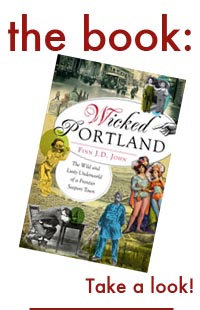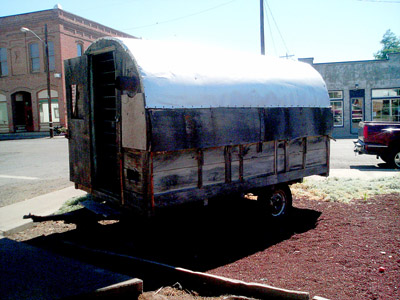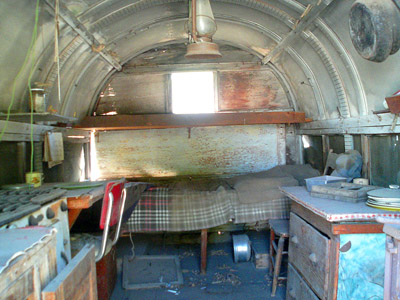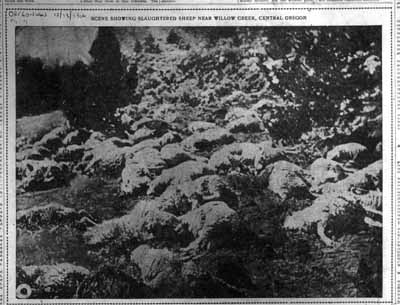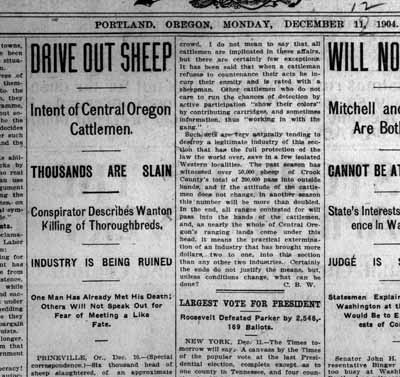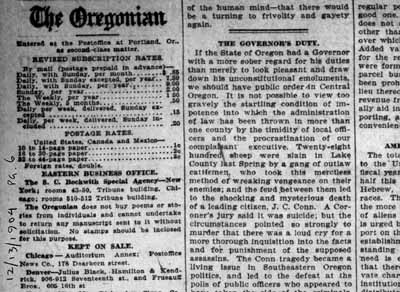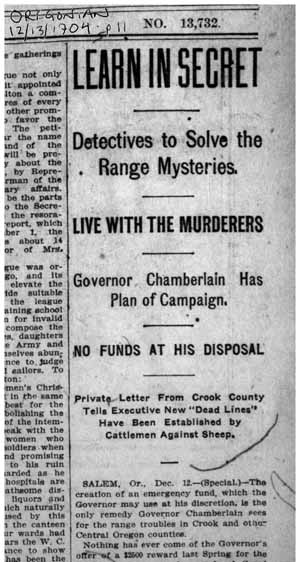Oregon’s cattleman-sheepman
war: 10,000 wooly casualties
Growing tension over rights to run livestock on Oregon's publicly owned rangeland led to the formation of the “Izee Sheep Shooters,” a secret society of cattlemen dedicated to the extermination of their animals' fuzzy rivals.
This authentic sheepherder's wagon, built in the 1930s and last used in
1984, is now on display in a city park in Fossil, Ore., once the heart of
Central Oregon sheepherder country. It was home for the sheepherder
and his dogs 12 months a year as they followed the flock over the range.
This particular unit was donated by the Steiwer family.
By Finn J.D. John — September 19, 2010
Downloadable audio file (MP3)
When you hear the term “range war,” chances are you think of the movie "Shane," with Alan Ladd.
Or maybe you're a pulp-Westerns fan, and your mind goes straight to the 1880s Pleasant Valley massacre in Arizona — the one Zane Grey wrote about in “To the Last Man.”
It isn’t widely known, but Oregon had its own range war, in central Oregon. It simmered for decades and finally boiled over into violence in the first few years of the 1900s. But if Grey had written its story, he probably would have titled it “To the Last Sheep.”
Range belonged to everyone and no one
The rangeland of central and eastern Oregon was, at the time, unregulated and public, and for many years the big cattle outfits had let their animals run on it. Of course, because it wasn’t their land, they had no real incentive to take care of it, and they didn't — but that was mostly OK, because cattle are picky eaters. They might chew the regular grass down to the roots, but they’d leave various other weeds behind to at least hold most of the soil in place.
By the 1890s, though, more than 100,000 wooly white interlopers were competing with the cattle for prime grazing lands. And sheep don’t mind eating a weed. So when a sheepman let his flock overgraze a field, the result was a more extreme form of damage.
Rising tensions
Sheepmen were also harder to keep tabs on. They lived out of specially built wagons — the predecessor to the modern camp trailer — with stove, kitchen and sleeping berth, pulled from grazing site to grazing site by a horse or two. They tended their flocks on foot. Often the way a cattleman would figure out where they were was when he’d drive his herd for days to a high meadow only to find that a flock of sheep had taken it down to dirt and rocks.
It wasn’t the kind of situation that usually ends well.
Enter the "Sheep Shooters"
This photograph of hundreds of dead sheep near the town of Heppner
ran in the
Dec. 13, 1904, edition of The Morning Oregonian.
In this case, it ended in the formation of something called the “Izee Sheep Shooters” in Grant County in the mid-1890s. This enterprising group of cattlemen had a fairly simple business model: Sneak up on a sheep camp, capture the sheepman, tie him to a tree and slaughter the entire flock with gun, knife or club, right on the spot. Participants were sworn to secrecy and agreed that although murder was not their goal, if a sheepman were killed during an operation he would be buried on the spot and nothing said.
After these fellows got a few successful operations under their belts, at least one similar organization sprang up, in neighboring Crook County.
Sheep begin to die ...
The cattlemen’s operations really got going in the early 1900s, with single-operation kills of 2,400 sheep at Benjamin Lake in 1903; 3,000 in a corral at Silver Lake, and later 2,300 in the same place, in 1904; and 1,000 in the Ochoco Mountains in 1905. Of course, there were many smaller operations involving flocks of just a few hundred or a few dozen.
... sheepherders try to solve things peacefully
The sheepmen, fortunately, did not respond in kind — probably because their solitary sheepherders in their big, highly visible camp wagons were so much more vulnerable than were the cowboys. Cowboys slept in bunkhouses or in discreet, hidden camps under the stars and were, thanks to their horses, capable of scouting much larger areas. Had the sheepherders responded to the invitation to escalate the violence, they would not have fared well.
The Morning Oregonian's editorial on the morning of Dec. 13, 1904, in
which it blamed then-Governor George Chamberlain (a Democrat, and
therefore a mortal enemy of the Oregonian's fearsome editor, Harvey
Scott) for the situation.
Instead, they complained to authorities, asking county officials to do something about it. Sheep shooters responded by urging county authorities to mind their own business and not get involved — advice the local governments, for the most part, took. Sheepmen also tried to arrange meetings with cattlemen to work matters out amicably, but the cattlemen — probably sensing that they had the upper hand — weren’t interested. A $1,500 reward was offered for information leading to the arrest of the sheep shooters, but no one needed the money badly enough to turn rat for it.
Death of Creed Conn: A lethal mystery
Everyone knew it was a matter of time before something happened and someone died. And this may have happened — the sheep shooters certainly wouldn’t have announced it if it had. Indeed, there was one death, that of storekeeper Creed Conn in Silver Lake — officially ruled a suicide but considered so deeply suspicious that the daily Oregonian newspaper frankly called it a murder.
In her book, The Grassy Knoll Murder, Christmas Valley historian Melany Tupper argues convincingly that the Conn murder was unrelated to the sheep shooters, but that the killer took advantage of the simmering range war to try to shift the blame. She's probably right. (For more information about Conn and the local character who most likely killed him, check out this Offbeat Oregon History article, the first in a two-part series about him.)
On Dec. 13, Oregonian readers learned of the
governor's plan to infiltrate the "Sheep Shooters"
with spies. Nothing came of this.
Federal government solves problem
But Oregon's range war never went farther than that, probably because the problem was solved by Uncle Sam.
In a move surely at least partly inspired by the violence and the damage to land that the old system encouraged and rewarded, the federal government — which, remember, was the actual owner of most of the land being fought over — took action in 1906. It ordered the rangeland supervisor to divide the public land into grazing allotments and give them exclusively to one operator apiece, for a fee.
Controversy fades away
With the public rangeland suddenly off-limits to all but one cattle or sheep operation, there was no longer anything to fight over, and if one operator was grazing on another’s allotment, it was clear to all which was in the wrong. So Central Oregon’s range war just faded away.
By the time it did, more than 10,000 sheep had been killed and at least one sheepherder wounded by a stray bullet.
Not a single “sheep shooter” was ever publically identified.
(Sources: Cole, Leslie & al. Insider’s Guide to Bend and Central Oregon. Boston: Globe Pequot, 2002; “The Sheep War in Oregon,” The New York Times, July 14, 1896; Jette, Melinda. “The Central Oregon Range Wars,” Oregon History Project (Ore. Historical Soc.), www.ohs.org, 2004.)
TAGS: #Prineville #OchocoMountains #BenjaminLake #SilverLake #GrantCounty #LakeCounty #Vigilante #Outlaw #LynchMob #Murder #Shooting #Cattlemen #Sheepmen #Basque #Cowboy #PublicLand #IzeeSheepshooters #CreedConn #LeslieCole #MelindaJette #MelanyTupper
-30-

